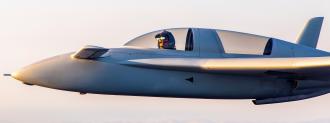It is man against machine in a battle in the sky: a human pilot faced off against a virtual jet flown by artificial intelligence.
The human pilot donned an augmented reality headset that displayed his virtual opponent — a Chinese stealth fighter jet. This was the first “human vs. AI” airborne fight of its kind.
The pioneering flight follows a virtual dogfight hosted by DARPA, the U.S. military’s research division, earlier this year. During the program, called Alpha Dogfight, pilots flew simulated F-16 fighter jets in virtual environments. But the pilots didn’t get off the ground. Instead, they fought AI opponents while wearing virtual reality headsets — still, the AI won.
Now, in a world’s first, Daniel Robinson, a veteran F-22 pilot, climbed inside a real aircraft and battled an AI virtual fighter.
Practice Makes Perfect
These virtual war games open up new doors for training in the U.S. military. Often, the only way to train airmen is with real pilots who oppose them in air-to-air combat training. The U.S. military is increasingly relying on contractors to provide “red air” adversary support. But physically flying against adversary aircraft pilots is costly and inefficient. Earlier this year, the Air Force hired several companies — in a multi-billion dollar contract — to get the support they needed to help pilots train across the U.S.
But so-called “red air opponents” are hard to come by.
“For the U.S. Air Force alone, it is a multibillion-dollar-a-year problem and is proving increasingly problematic to solve, given the chronic lack of front-line pilots and an aging fleet of aircraft that are no longer capable of simulating the most current threats,” Robinson said, Signal reports.
If widely deployed, this fleet of non-human opponents could significantly reduce air combat training costs and expose students to more training opportunities.
Getting Off The Ground
In the test flight, the unlikely opponents took off from Camarillo Airport, California.
Robinson operated a real jet while monitoring his virtual challenger via an augmented reality headset with a mounted display. The display showed a computer-generated projection of a Chinese stealth fighter jet flown by his AI opponent. It was developed by EpiSci, a U.S.-based autonomous technology company. They are known for their autonomous technology used in defense, aerospace, and commercial applications.
“With this first-ever within-visual-range dogfight against an AI bandit, EpiSci’s Tactical AI demonstrated the ability to work on a real aircraft, with flight-ready hardware and sensors,” said Chris Gentile, EpiSci’s Vice President for Tactical Autonomous Systems, reports The Drive.
Pilots of the future will need to be comfortable teaming with AI — and training is the ideal place to introduce this technology.
Chris Gentile
Red 6 developed the simulation Robinson was interacting with — a company Robinson founded. By projecting the fighter jet on Robinson’s headset, it appears to insert the jet into the real-world environment. The jet-projection interacts with the real surroundings, even in the high-speed environment. The human pilot could look around, see, and interact with his virtual opponent as if it were really there.
“Pilots of the future will need to be comfortable teaming with AI — and training is the ideal place to introduce this technology,” Gentile told The Drive.
A spokesperson for Red 6 said there was no winner or loser in this dogfight — the flight was designed to test specific training goals for future missions.
Edit Note: This article has been updated with a statement from Red 6 stating that the flight was designed for training purposes only and no clear winner/loser was announced.






